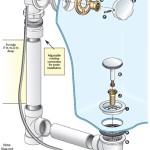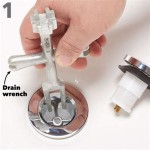Dimensions of Standard Bathtub Size: A Comprehensive Guide
The bathtub remains a focal point in many bathrooms, offering a space for relaxation and personal hygiene. When planning a bathroom renovation or construction project, understanding the dimensions of standard bathtubs is crucial. These dimensions influence functionality, space utilization, and overall bathroom design. Various factors, including user needs, bathroom size, and desired aesthetics, contribute to the selection of an appropriate bathtub size.
This article provides a comprehensive overview of standard bathtub dimensions, exploring different types, key considerations, and the impact of size on various aspects of bathroom design. The information presented aims to offer a clear understanding of bathtub dimensions to facilitate informed decision-making in bathroom planning and renovation projects.
Understanding Standard Bathtub Dimensions
The term "standard bathtub" often refers to the alcove bathtub, a common design intended to fit within a three-walled recess. Standard dimensions for alcove bathtubs generally fall within a specific range, but variations exist depending on the manufacturer and design. Length, width, and depth are the primary measurements to consider when evaluating bathtub dimensions.
Length: The length of a standard alcove bathtub typically ranges from 60 inches (152 cm) to 72 inches (183 cm). The 60-inch length is the most common, fitting well in many standard-sized bathrooms. Longer tubs, such as 66-inch or 72-inch models, provide more space for stretching out and can be more comfortable for taller individuals.
Width: The width of a standard alcove bathtub usually ranges from 30 inches (76 cm) to 32 inches (81 cm). This dimension determines the overall footprint of the tub and the amount of space it occupies in the bathroom. Wider tubs offer more bathing space but require more room in the bathroom layout.
Depth: The depth of a bathtub refers to the distance from the top of the rim to the bottom of the basin. Standard bathtub depths typically range from 14 inches (36 cm) to 20 inches (51 cm). A deeper tub allows for a more immersive bathing experience, while a shallower tub may be easier to enter and exit, particularly for individuals with mobility concerns.
It is important to note that these dimensions are general guidelines. Specific models may vary slightly, and it is always advisable to consult the manufacturer's specifications for precise measurements before making a purchase. Furthermore, building codes and accessibility standards may impose additional requirements regarding bathtub dimensions and clearances.
Variations in Bathtub Types and Sizes
While alcove bathtubs represent a common standard, numerous other bathtub types exist, each with its own set of typical dimensions. These variations cater to different aesthetic preferences, space constraints, and functional requirements. Exploring these alternatives can help in selecting a bathtub that best suits specific needs and bathroom configurations.
Drop-in Bathtubs: Drop-in bathtubs are designed to be installed within a framed enclosure, often customized to match the bathroom's design. The dimensions of drop-in tubs vary widely, as they are not constrained by the dimensions of a standard alcove. Lengths can range from 60 inches to over 72 inches, and widths can extend beyond the standard 32 inches. The flexibility in sizing makes drop-in tubs suitable for various bathroom layouts and design preferences.
Corner Bathtubs: Corner bathtubs, as the name suggests, are designed to fit into the corner of a bathroom. Their dimensions are typically larger than standard alcove tubs, with lengths and widths often exceeding 60 inches. The triangular or pentagonal shape of corner tubs provides ample bathing space and can create a visually striking focal point in the bathroom.
Freestanding Bathtubs: Freestanding bathtubs are not attached to any walls and can be placed anywhere in the bathroom where plumbing connections are available. They offer a modern and luxurious aesthetic and come in a variety of shapes and sizes. Lengths commonly range from 60 inches to 72 inches or more, and widths can vary significantly depending on the design. The height of freestanding tubs also differs, with some models featuring a low profile and others standing taller.
Japanese Soaking Tubs (Ofuro): Japanese soaking tubs, also known as Ofuro, are typically shorter and deeper than standard bathtubs. Their design emphasizes soaking in hot water while sitting upright. Common dimensions for Japanese soaking tubs include a length of around 48 inches (122 cm) and a depth of 24 inches (61 cm) or more. These tubs are well-suited for smaller bathrooms and offer a unique and therapeutic bathing experience.
Walk-in Bathtubs: Walk-in bathtubs are designed for individuals with mobility issues, featuring a watertight door that allows easy entry and exit. Dimensions vary depending on the manufacturer and model, but they are generally shorter and taller than standard bathtubs. Lengths typically range from 48 inches to 60 inches, and heights can exceed 40 inches. The primary advantage of walk-in tubs is their accessibility, providing a safe and comfortable bathing experience for users with limited mobility.
The selection of a bathtub type and size should consider the available space, user needs, and desired aesthetic. Each type offers unique advantages and disadvantages, and careful evaluation is necessary to ensure the chosen bathtub meets the specific requirements of the bathroom design.
Key Considerations When Choosing Bathtub Dimensions
Selecting the appropriate bathtub dimensions involves careful consideration of various factors beyond mere aesthetics. The functionality, comfort, and accessibility of the bathtub are all influenced by its size and shape. Evaluating these factors ensures that the chosen bathtub meets the needs of all users and integrates seamlessly into the bathroom environment.
User Height and Body Size: The height and body size of the primary users of the bathtub should be a primary consideration. Taller individuals require longer tubs to comfortably stretch out and fully immerse themselves in the water. A tub that is too short can lead to discomfort and a less enjoyable bathing experience. Similarly, the width of the tub should accommodate the user's body size, allowing for comfortable movement and relaxation.
Bathroom Size and Layout: The size and layout of the bathroom are critical factors in determining the appropriate bathtub dimensions. A large bathtub may overwhelm a small bathroom, making it feel cramped and restricting movement. Conversely, a small bathtub in a large bathroom may appear disproportionate and fail to utilize the available space effectively. Careful measurements and consideration of traffic flow patterns are essential to ensure the bathtub fits comfortably within the bathroom layout.
Accessibility Needs: Accessibility is a crucial consideration for individuals with mobility issues, elderly users, or those with disabilities. Walk-in bathtubs offer the best accessibility, but other options, such as tubs with lower sides or grab bars, can also improve ease of use. The depth of the tub should be carefully considered, as a shallower tub is generally easier to enter and exit. Furthermore, adequate space around the bathtub is necessary to allow for maneuvering with mobility aids, such as wheelchairs or walkers.
Water Heater Capacity: The capacity of the water heater should be sufficient to fill the bathtub without running out of hot water. Larger bathtubs require more water to fill, and an undersized water heater may result in a cold or lukewarm bath. Estimating the bathtub's water capacity and comparing it to the water heater's capacity is essential to ensure a comfortable and enjoyable bathing experience.
Budget: Bathtub prices vary significantly depending on the type, size, material, and features. Larger bathtubs typically cost more than smaller ones, and specialty tubs, such as freestanding or walk-in models, can be significantly more expensive. Establishing a budget before beginning the selection process helps to narrow down the options and avoid overspending. Consider the long-term value and potential benefits of different bathtub types when making a decision.
Installation Considerations: The installation of a bathtub can be complex and may require professional assistance, particularly for specialized models, such as freestanding or drop-in tubs. Ensure that the bathroom floor is level and structurally sound to support the weight of the filled bathtub. Plumbing connections must be properly installed and accessible for maintenance. Consider the cost of installation when evaluating different bathtub options.
By carefully considering these factors, it is possible to select a bathtub with dimensions that meet the needs of all users, integrate seamlessly into the bathroom environment, and provide years of comfortable and enjoyable bathing experiences.

Standard Bathtub Sizes By Type To Help You Choose The Perfect Tub

Best 25 Standard Tub Size Ideas

How To Choose Bathtub Sizes

Standard Bathtub Sizes By Type To Help You Choose The Perfect Tub

Are Bathtub Sizes The Rough In Size Or Tub Interior Home Improvement Stack Exchange

Bathrooms And Layouts Residential Bathroom Design

What Is The Standard Size Of A Bathtub

Universal Tubs Hd Series 60 In Left Drain Step Walk Soaking Bath Tub With Low Entry Threshold White Hdsi3060lws The Home Depot

Built In Bathtub Dimensions

Standard Bath Size Length Width Dimensions








